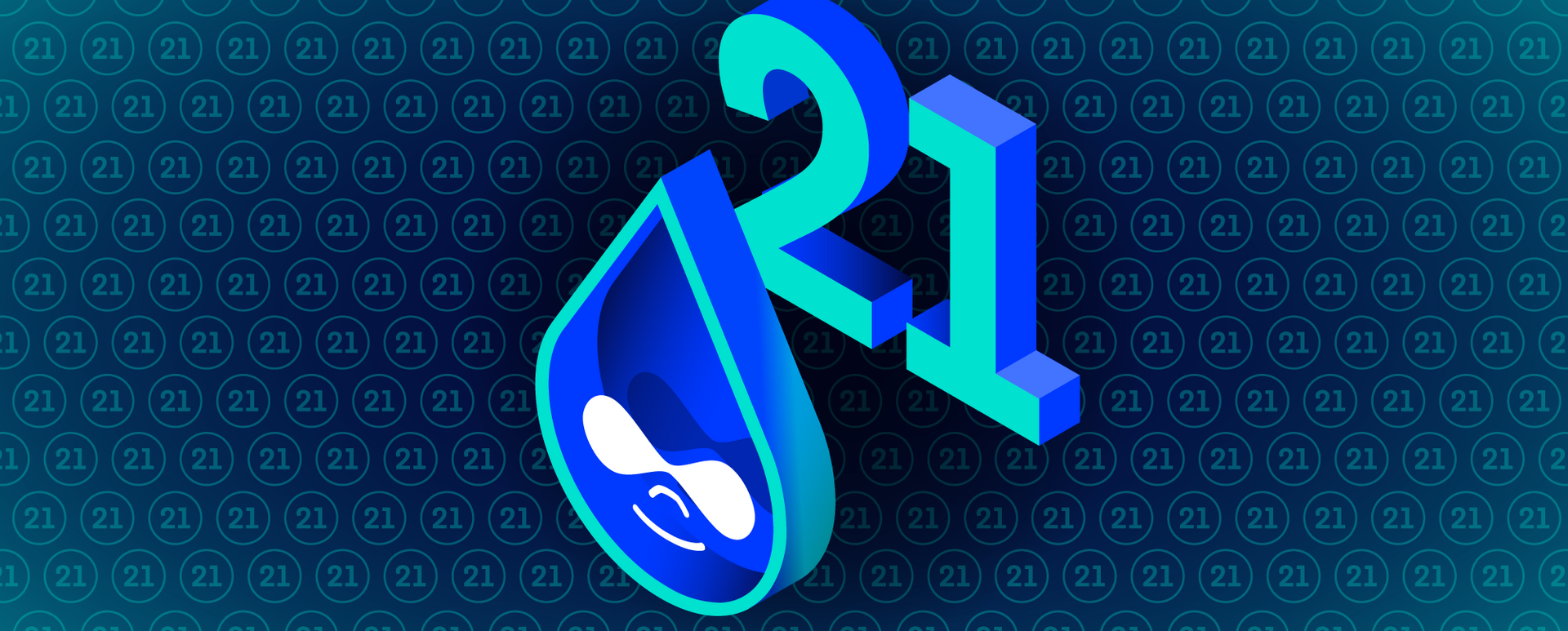
Celebrating Drupal 21st Anniversary! How has it Been Helping Businesses?
Happy birthday, Drupal! It’s been 21 years since the release of the first stable version of our favorite open source content management system. With each subsequent year, it allows for creating more and more complex, modern, and responsive websites for companies of all sizes. Let’s take a look at Drupal possibilities over the years, the projects it's been used for, and the planned functionalities.
Drupal’s growth
Long before it became a system used by many websites and applications around the world (including the ones owned by prominent internet companies like Pinterest), Drupal had only 18 files called modules. They were able to interact both with each other and the core framework. That’s how Drupal 1.0.0, launched on the 15th of January 2001, operated.
The repository of Drupal 1.0 on GitLab.
While working on that very first version, Dries Buytaert - Drupal founder - just wanted to create something for himself, as he wrote in his article for Drupal’s 20th birthday. However, soon after the release, the developer started to think about the other users of this content management system. As a result, Drupal 2, also launched in 2001, included support for translation and localization so that the users could have different languages than English on their websites. That version also contained the improved modules.
Drupal 3 and 4
Half a year later, the enthusiasts of this CMS could already try Drupal 3 which introduced the notion of nodes. They were types of content that can be used on the website, for example, articles or subpages. They were also meant to give the possibility for reusing existing code and this way - mitigate the size and the complexity of the system. The abovementioned release also brought pretty important modules for the business - blog, and statistics.
With the release of almost one year older brother, Drupal 4, a very important project was launched - the Views module. Thanks to it, the users could build the queries in the admin interface. It enabled them to make a list of items ordered by some factor, e.g. a list of engines sorted by their capacity. Such an element could also have a title, teaser, and some other data. It was a great improvement for the less technical end user as they didn’t have to code any of the abovementioned elements.
Drupal 5 and 6
For Drupal’s 6th birthday, a gift for its users was a new (the fifth) version of the system. It introduced the creation of the node types (e.g. a text description, or a banner) which had been previously possible only with the Content Construction Kit (CCK) module. That change improved the editorial experience.
The other enhancements that Drupal 5 brought were:
- better user management, e.g. filtering users by role,
- more logs, for better monitoring of what’s happening on the website,
- performance improvements (which resulted in faster loading of the web pages).
Then came the release of the 6th version which allowed for faster installation of a Drupal project. During that process, the users could already choose a language from the plethora of available languages. What’s more, Drupal 6 provided better for support multilingual interface and the possibility to translate the website on the fly, with a help of an additional module.
Drupal 7 and 8
Introduced as a friendly and robust CMS for creating nearly any type of web page (microsites, blogs, and even collaborative social communities), Drupal started moving towards being a digital experience platform. What does indicate it? With the 7th version, many new modules appeared which allowed for even better adjusting of websites to the needs of a given business and its customers. The daily work of editors improved with the built-in function for adding graphics to the content. Also, the already mentioned facilitation for the less technical end user - the Views module - gained a new (third) version. However, the tool still had to be installed additionally. Another big change was the transfer of the entire functionality of the CCK module to Drupal 7 which made it possible to add fields to the nodes. It meant that besides the standard fields, like title or body, we could add any field to the node.
In the next main release, the abovementioned module was added to the Drupal core. Other than that, Drupal 8 brought revolutionary changes. The system has been rewritten using Symfony, a PHP framework. As a consequence, Drupal also got a new template engine - TWIG - which made it easier and more comfortable to create templates.
This system’s usability has also improved by:
- implementing a new page editor,
- adding the mobile version as a built-in option,
- including the Media module, a stable version of the Workflows module (both released in Drupal 8.4), as well as a stable version of the Layout Builder module (released in Drupal 8.7) in the core.
Drupal 9
After the retirement of Drupal 8, whose support has ended in November 2021, Drupal 9 is now the recommended version of this CMS. Its release brought some valuable enhancements. Two of them are improving the page loading speed due to usage of PHP version minimum 7.3, and reducing the time needed to create new modules, thanks to the implementation of the newest (fourth) version of Symfony.
Innovative features and benefits for various businesses
Over the course of so many years and technological changes, Drupal has always remained relevant. It’s because of the community-driven innovation. The specialists (from various organizations and freelancers) gathered around this open source system have been following the emerging trends as well as the changing needs of the companies for which they worked. As a result, Drupal includes a host of useful features and benefits for different businesses.
Flexibility and scalability
Drupal works well for small web pages, such as portfolios, and big corporate websites having separate versions for different branches or several language versions of the same site. The latter is possible due to Drupal multisite installation which is able to support more than one web page on a single codebase.
As a particular company and its needs grow, the Drupal website can be further extended. It’s possible due to various properties of this CMS, for example, the fact that it uses the components of Symfony - a framework perceived in the PHP environment as the best for creating complex websites.
Drupal can be adjusted not only to a particular company’s size but also to its industry and specific requirements. We can flexibly customize it thanks to the availability of various core and contributed modules to create a web page for a university, news website, Intranet system, or online store. Introducing shopping to Drupal is possible with the Commerce module. It enables us to create a standard online store, the one selling digital products, and even a marketplace.
Open source nature
The possibility to use all the features and modules is assured by the fully open source nature of Drupal. It means that the source code is available for free to everyone, so both individuals and businesses don’t have to pay for a license. Also, contrary to the proprietary software, there’s no vendor lock-in. Then we aren’t limited to using the support and services of only one organization (the authors of a commercial solution) but can freely choose the Drupal development experts we want to cooperate with.
Without commercial support, we don’t have to worry that the system is outdated since the developers from the Drupal Community regularly release new versions, with improvements and fixes, every six months.
Headless CMS
Another great benefit of this CMS and proof of its huge development over time is the fact that Drupal can be used as headless software. In such a case, this open source solution operates as the backend content repository, whereas the frontend is created of other technologies and communicates with Drupal via API. How does the headless approach help the companies? Within such a solution, the content from the CMS can be sent to multiple channels. Besides the website, it can be transferred via API to mobile applications or IoT, to name but a few.
Quality software for companies around the world - examples
The rich features and possibilities of this CMS have been appreciated by the owners of over a million websites that run on Drupal. The list of the companies that selected this open source content management system includes such famous names as NASA, Tesla, NBA, and the Grammy Awards.
At Droptica, we use Drupal every day, developing websites and applications for various businesses. The Polish Football Association (PZPN) gained a complex headless Drupal CMS that feeds with data its internal systems and the websites Football Connects Us, PZPN Library, and From the Backyard to the Stadium.

For Here.com, the mapping and location company, we’ve developed a digital experience platform that operates as a starting point for launching websites. Once it’s created, a new web page automatically gets a nice look and feel. The editors can start adding content and customize the visuals.
The corporate website of Here.com
We’re also helping programers and less technically experienced users build their websites by developing our Drupal distribution - Droopler. It enables the easy creation of web pages from ready-made components. The knowledge of coding isn’t necessary. We get a functioning site only by clicking different configurational options.

The Traning Realm landing pages use Droopler.
Drupal Association and Drupal Community
In the anniversary article, we can’t fail to mention the two special organizations behind Drupal. First one them, the Drupal Association fosters Drupal’s growth by educating people about this CMS, as well as supporting projects and initiatives related to it. Everyone (both individuals and companies) can become a member of the Drupal Association by financially supporting this non-profit organization.
The second group of people is the Drupal Community. Thanks to the work of its members - the volunteers - we have the whole code of this open source system. This huge team is always growing, active, helping others to use Drupal, and adding new features and improvements to it. We can meet the people involved in the Drupal development during the biggest event - DrupalCon North America, or more local ones, like DrupalCamp Poland.
Drupal anniversary - summary
Working with Drupal for over ten years, we’re sure about its constant development and benefits for business. As for now, we’re looking forward to the release of Drupal 10 which is planned for June 2022. The same as the update from the eighth version to the ninth, Drupal 10 is supposed to be an evolution, not a revolution. What new will it bring?
- Oliviero as a default theme,
- introduction of CKEditor 5,
- introduction of automatic update.
These are only a few planned improvements, but we’re convinced that (together with the rest) they’ll make the work with Drupal even smoother.











